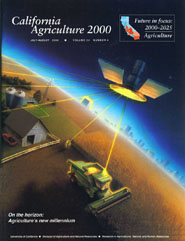All Issues

On the horizon: Agriculture's new millennium
Cover:
On the wired farm of the future, growers may use advanced information technology to precisely monitor water needs, weed and pest pressure, soil, and other factors on small field sections. Site-specific management will be used in concert with other developing technologies. The increasing popularity of biologically integrated and sustainable farming systems, along with new agricultural biotechnology for crops and live-stock, could significantly transform the way food and fiber are produced in the 21st century. Illustration courtesy of John Deere Company.
July-August 2000
Volume 54, Number 4
Volume 54, Number 4





